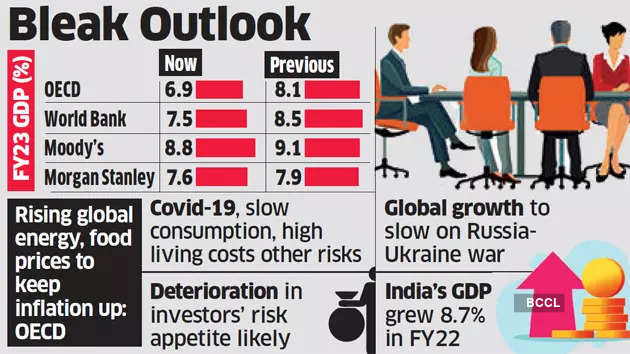
The Organisation for Economic Cooperation and Development (OECD) has joined the World Bank and sharply slashed the growth for India to 6.9% growth in FY23 from 8.1% estimated earlier. This is below the Reserve Bank of India‘s estimate of a 7.2% rise. India’s Gross domestic product (GDP) grew 8.7% in 2021-22, making it the fastest-growing major economy in the world.
“Real GDP is projected to grow by 6.9% in fiscal year (FY) 2022-23 and 6.2% in FY 2023-24, despite a pick-up of corporate investment facilitated by the Production-Linked Incentive Scheme,” OECD said in its latest economic outlook.
On Tuesday, the World Bank similarly severely pared India’s FY23 forecast to 7.5% from 8.5% in the April review.
“After recording the strongest GDP rebound in the G20 in 2021, the Indian economy is progressively losing momentum as inflationary expectations remain elevated due to rising global energy and food prices, monetary policy normalises and global conditions deteriorate,” OECD said in the report.
The report said while inflation will gradually decline, the current account deficit would widen due to the surge in energy import costs.
The Paris-based organisation suggested the RBI “gradually move towards a more neutral monetary stance” given the financial and social costs of high inflation.
The RBI on Wednesday hiked key repo rate by 50 basis points (bps) to 4.9% in a bid to tame soaring inflation in the country. It began monetary policy tightening in May, intending to anchor inflation expectations and limit second-round effects. OECD expects policy rate to rise to 5.3% by the end of 2022 and remain there in 2023.

“The government should counter signs of a rapid deterioration in living standards with income support for vulnerable households,” OECD said, and cautioned that risks include the appearance of a new Covid variant, failure to tame inflation, a reversal of capital flows to emerging markets, and a significant widening of the current account deficit.
It noted that monetary policy normalisation and weaker external demand will weigh on GDP growth in FY23 and FY24, though strong government spending would continue to support activity.
An ambitious set of measures to simplify the business environment, create a ‘bad bank’ (National Asset Reconstruction Company) tasked with cleaning up balance sheets, and improve logistics is expected to mitigate the impact of higher credit costs on private investment, according to the organisation.
“However, households maintain cautious views regarding short- and medium-term prospects, amid signs of labour market softening, deteriorating purchasing power and flattening real incomes,” it said.
The 38-member organisation expects the global economy to expand 3% in 2022, down from 4.5% it predicted in December, while inflation is forecast at around 9%.
Slow consumption
OECD said consumption growth has slowed in India with sales of two-wheelers falling to a 10-year low, subdued private sector credit growth and contracting employment, although companies report difficulties in filling vacancies. “Consumer price inflation for energy-related items and edible oils started trending up even before Ukraine war and has accelerated afterwards…Inflation has also risen and become wideranging,” it said.
Wholesale inflation in India surged more than expected to a record 15.08% in April, whereas retail inflation hit an eight-year high of 7.79%.
While the direct impact of the war in Ukraine is relatively limited, as trade between India and both Russia and Ukraine is small, but for selected industries – pharma and weapons – Russia is an important destination and source.
Also Read:
